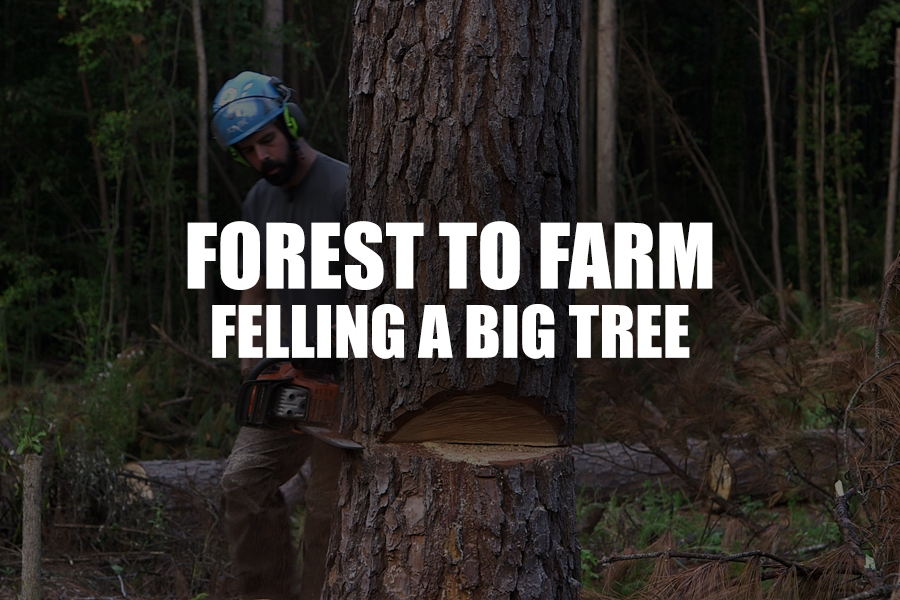Hey guys! Brian and Terry here with another installment in our Forest to Farm series here on Survival Dispatch. We’ve been cutting a lot of smaller trees, so we haven’t taken your time showing you the same thing over and over. But today we are knocking down a big boy, and those are always fun, so we thought we’d share it with you. We also go through moving the logs for later use in a barn.
One thing to keep in mind is, this was early on in our adventure. We were just getting started good and also spending a lot of money on everything we were doing, so we overlook some necessities that we thought weren’t really needed at the time. I’m referring to what we recently covered with Husqvarna, and that would be proper PPE, or chaps in this case. I don’t have chaps on in this video and I should have but didn’t have any at the time. It was foolish and I should have known better. I don’t dare touch a saw without them now.
The tree we are working on today is a Loblolly Pine and is about 26”-28” in diameter. My Husqvarna 455 Rancher has a 20” bar. When working trees larger than your saw, it takes a little more time and you have to work back and forth. Just be sure to take your time, go slow and steady, and don’t take too much at one time. If you take more hinge on one side than you should, the tree can very quickly jump, pop, and go in the wrong direction because of how the hinge is pulling on it. We’ll get into this in more detail later on.
Once I’ve made my face cut, I always try to make a ring in the bark with my saw from one edge of the face cut to the other. This way, I know where the center of my face cut is and where I need to be cutting above that line no matter where I am cutting on the back side of the tree.
Once I’ve got a decent cut depth going, I always set a wedge into the cut. By doing this, I secure the opening if a wind comes up unexpectedly. I have had times early on where I didn’t get a wedge in, and the wind started blowing. When this happens, there is a good chance the tree will sit down on your saw, and you are stuck with your saw pinched between thousands of pounds of wood. You can’t do anything but wait for the wind to subside. This isn’t a place I like to be in. So, but putting a wedge in, it locks that gap open and keeps you running your saw as you need, our removing the saw from the tree as needed.
Now that the wedge is set, I continue making my cut to fell the tree.
As I notice the tree starting to move, I immediately remove my saw and get out of the area. You don’t want to be nearby if the tree jumps in an unexpected direction, or hits something on the ground and bounces back toward the stump. Yes, they weigh thousands of pounds, but they bounce like a rubber ball when they hit the ground, haha.
As you can see in the above photos, the bottom of the tree jumped over eight feet off the ground after its initial impact. There’s a TON of force as it’s moving through the air. Definitely not an area where you want to be in when it is jumping around uncontrolled.
You don’t just have to worry about the stump end when it’s falling. Even though Terry was a ways back from this tree when it fell and he was pulling on the guide rope, you can see that the top of the tree exploded when it hit the ground. Limbs and debris went flying everywhere. This doesn’t always happen, but when it does you need be out of that area. So, make sure you are always a safe distance away from the landing zone. If it’s a 100 foot tall tree, be at least 150 feet from it.
Now that the tree is down, it’s time to start processing it. We hope to eventually get a sawmill, mill these big logs, and build a timber frame barn. It would be so cool to have a bar we made form the trees on our property that we cut and processed ourselves. We know that the machine we are using, a Bobcat E32, will haul about 2,000 pounds. We measured the diameter of the logs and calculated that we can carry roughly a 14-foot-long log. Plus, this gives us a very usable length for beams in the barn. So, we measure 14 feet and make a mark at each point in the bark with a hand saw.
After measure and making our marks, I come back with the chainsaw and cut up the sections of tree.
Then I come in with the mini-excavator and pick up each log to haul away for storage and futher processing.
We cleared an area back in the woods to store our logs and put sacrificial runners (large logs) under them to keep the stacks off the ground. Currently, we have stack about 140 logs to have for later. We’ve ended up with a nice mix of pine, sweetgum, oak, poplar, and cherry.
We hope you guys enjoyed today’s post and come back for more as we continue to move forward on the property! Next up, we’ve got to clean up all the mess from these trees. Thanks for stopping by!

